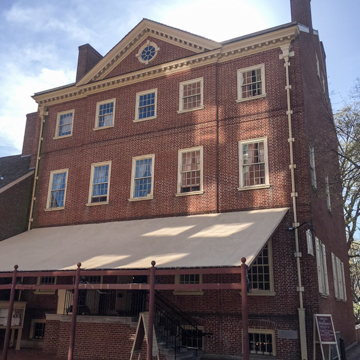A cluster of buildings within the National Park gives a sense of the nation's first financial district. Public-minded citizens built the City Tavern to support the economy of the city and as a place to combine business with pleasure—not unlike the construction of the Convention Center two centuries later. Here delegates to the Continental Congress and later to the Constitutional Convention met and caucused. John Adams noted in his diary for August 29, 1774, that the city's new tavern was “the most genteel one in America.” When the national government moved to Philadelphia, Alexander Hamilton's Treasury Department had offices just to the north on 2nd Street and offices for the new national bank found space in Carpenters’ Hall (PH12.7) before the First Bank of the United States (PH12.10) was completed in 1797.
After the Revolution, rooms were rented to the group that began the city's financial exchange. With Benjamin Henry Latrobe's now demolished Bank of Pennsylvania close at hand, S. 2nd Street below Chestnut was the nation's financial center. The exchange remained in the old city until the early twentieth century, moving first into the Merchants’ Exchange in 1833 (PH12.12), then to a James H. Windrim–designed building behind the Girard Bank (1875, demolished; see PH12.10), and next to the Wilson Brothers–designed exchange wing of the enlarged Drexel Building (1889, demolished). Other exchanges for commodities and products included the Corn Exchange (PH14.3) and, at the end of the century, the Bourse (PH13).


